Whether caused by soil erosion, compaction issues, or simply the passage of time, a void underneath a concrete slab such as a sidewalk or driveway is an issue that needs prompt and careful attention. In this blog post, we will guide you through the complex, yet manageable, steps on how the pros efficiently fill a void under a concrete slab. This essential read will provide you with actionable insights and clear directions on securing the ground beneath your feet, literally. If you’ve noticed puzzling dips in your driveway, patio, or sidewalk, you’ve landed on the right page!
Polyurethane Foam Lifting for Concrete Slabs
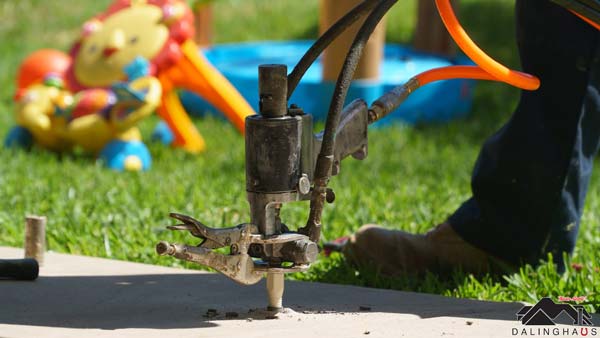
The best method for leveling uneven concrete slabs is via a process known as polyurethane foam lifting or polyjacking. When you hire a concrete repair company to provide this service for you, they’ll likely follow these basic steps to restore your concrete to a level state:
- Drill holes through the concrete: The first step in the concrete leveling process is identifying the areas where voids have formed. Drilling holes through the slab in these locations allows filling to take place.
- Inject polyurethane foam: Polyurethane foam quickly fills voids below the slab while raising the concrete back to its original position.
- Patch the holes: The final step in the polyjacking process is to patch the drill holes with cement to make them look like they were never there.
- Enjoy your leveled concrete slab: The polyjacking material dries and hardens quickly, allowing you to walk on your concrete shortly after the process.
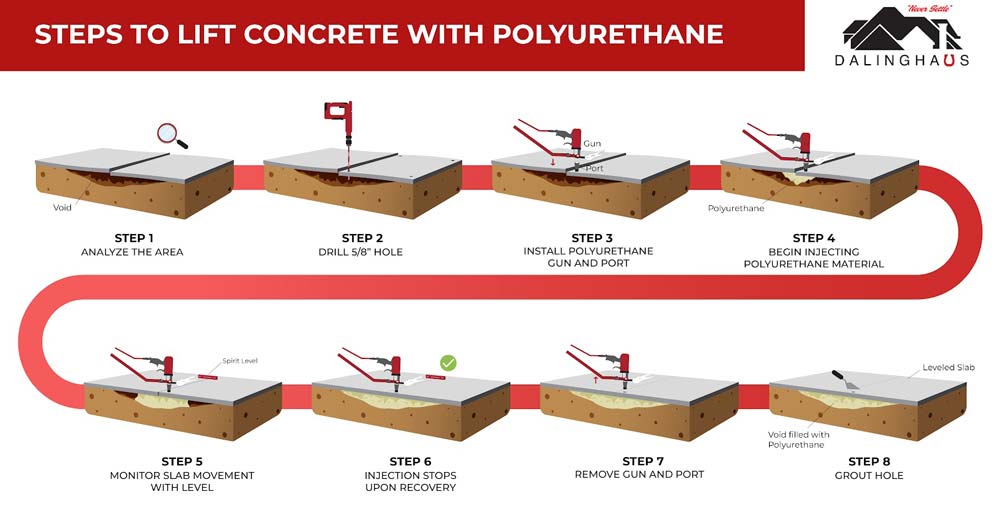
Advantages of Polyjacking over Mudjacking
If you have spent any time searching for a solution for your uneven concrete, there is a chance that you have come across an alternative to polyjacking, known as mudjacking. While these two processes are pretty similar overall, polyjacking proves to have the following advantages that make it the better approach:
- Smaller drill holes: Polyjacking requires smaller drill holes, making it a more discrete approach to concrete leveling that’s less likely to leave lasting marks.
- Cleaner process: Overall, the foam polyjacking material makes for less mess than the mud-like materials used in mudjacking.
- Lighter weight: Unlike polyjacking foam, mudjacking material is much heavier, placing a much greater strain on the soil below your concrete slabs.
- Quicker drying time: Mudjacking requires time to dry and harden. Alternatively, you can walk on your concrete immediately after the polyurethane foam lifting process.
- Greater longevity: Polyurethane foam does not allow moisture in, which gives the repair a longer lifespan in most cases.
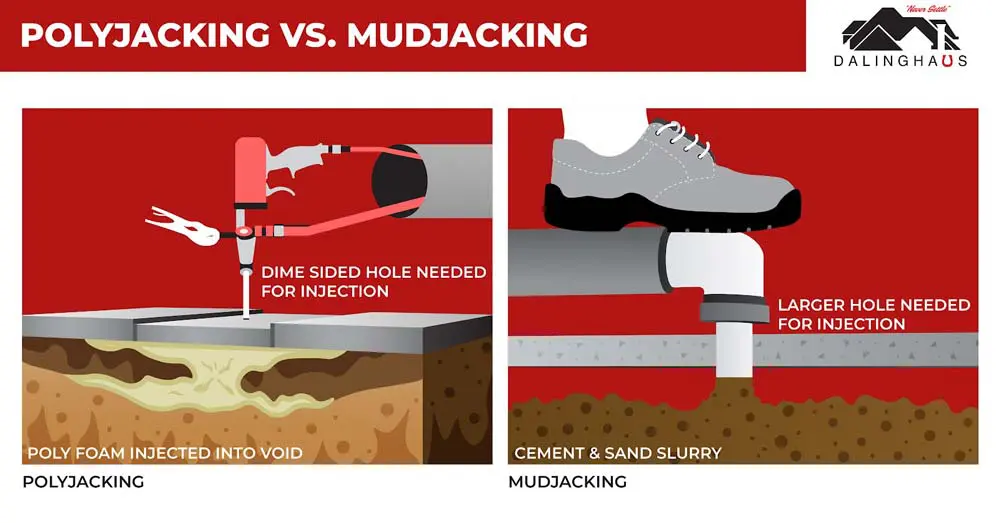
When it’s time to fill voids beneath a concrete slab, there is no better option than polyjacking. While mudjacking was once the concrete leveling method of choice, the list above reveals why the best concrete repair teams now rely on polyurethane foam as their go-to solution.
Reasons Why it’s Crucial to Level Uneven Slabs
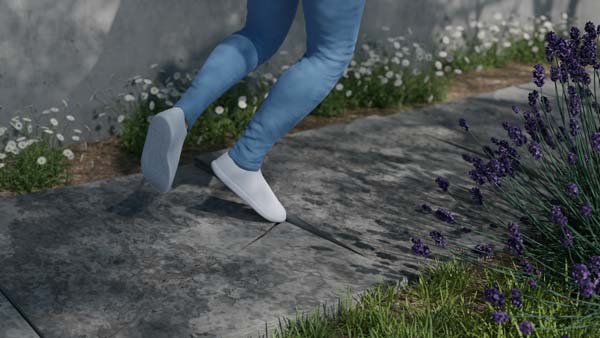
Understanding the ways to fix concrete slabs is a good start. However, it is equally essential to know why having your unlevel concrete fixed as soon as possible is vital. Below are a few of the top factors that should motivate you to hire a professional to make your concrete even once again:
- Uneven slabs make outdoor spaces unusable: When slabs become unstable due to voids, they make your walkways, patios, driveways, and other hardscape surfaces unusable, dramatically reducing the functionality of your yard.
- Uneven slabs cause a safety hazard: When adjacent slabs are not level, they present a tripping hazard that can easily result in an injury.
- Uneven slabs are unsightly: Slabs that become uneven are unpleasant to the eye, detracting from the overall visual appeal of your property.
Can You Level Concrete Slabs on Your Own?
Many homeowners quickly search for DIY solutions for the problems that arise on their properties. However, while DIY projects are often a great way to save money, you should not take a DIY approach to concrete leveling.
Attempting to complete a concrete leveling project on your own is challenging and unsafe. A better approach is to find a concrete leveling expert in your area who can complete this project efficiently and safely.
What Causes Uneven Concrete Slabs?
Now that you know more about how to repair concrete slabs and a few reasons why it is important to do so, let’s cover some of the basics of why this issue arises in the first place. In many cases, unlevel concrete slabs result from the same common cause. To understand that cause, you need to know how your concrete slabs interact with the soil below. Concrete slabs rest on top of that soil and depend on it for support. As such, if the soil shifts or sinks, the slab will likely move as well.
In many instances, the soil below a concrete slab may form voids or air pockets where soil once supported the slab directly. Once a void replaces that support, the slab will pitch towards that empty space, causing it to become unlevel.
The soil below a slab can shift for several reasons. For instance, the soil may not have been properly prepared before the slab was poured. Additionally, storms and other sources of water can cause soil to wash out.
Still, shifting soils are not the only cause of uneven slabs. Strong tree roots growing below the slab can also cause unevenness. Likewise, excessive weight on the slab can cause similar problems.
In cases in which soil voids cause uneven slabs, polyjacking is almost always the best solution. However, it’s best to consult a professional to determine the cause of your uneven slabs and the ideal solutions. If the slab is severely damaged, it may need to be replaced.
How Much Does it Cost to Level Concrete Slabs?
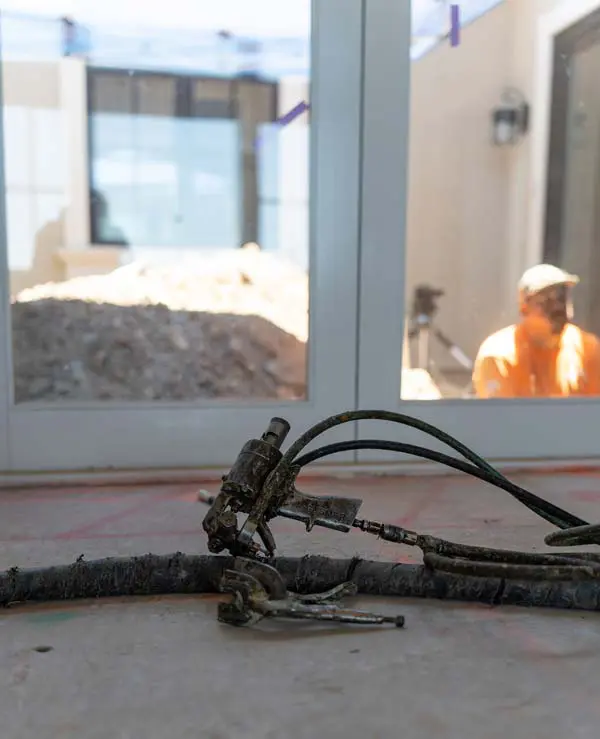
If you have uneven slabs on your property, you’re likely interested in finding a viable solution as quickly as you can. You’re also likely wondering how much that solution will cost.
As you’d expect, the cost of your concrete leveling project depends on many factors. However, it is safe to estimate that the average polyjacking project will cost about $15 to $25 per square foot.
The price of polyjacking inspires some homeowners to seek DIY solutions to unlevel concrete slabs. However, it is important for us to reiterate that this is not a wise approach. Instead, it is always best to seek the help of a concrete professional who can get the job done safely and correctly.
Get Help Leveling Your Concrete
As mentioned above, the best way to restore the function and beauty of your uneven concrete slabs is to hire a professional who can perform polyjacking for you. If you live in Southern California, Nevada, or Arizona, Dalinghaus Construction is the best team you can choose for this kind of project.
We have extensive experience with using polyurethane foam to level concrete. We also provide many other construction services, including foundation repair, crawl space repair, seawall repair, and much more. Contact us today to learn more about what we can offer you.






